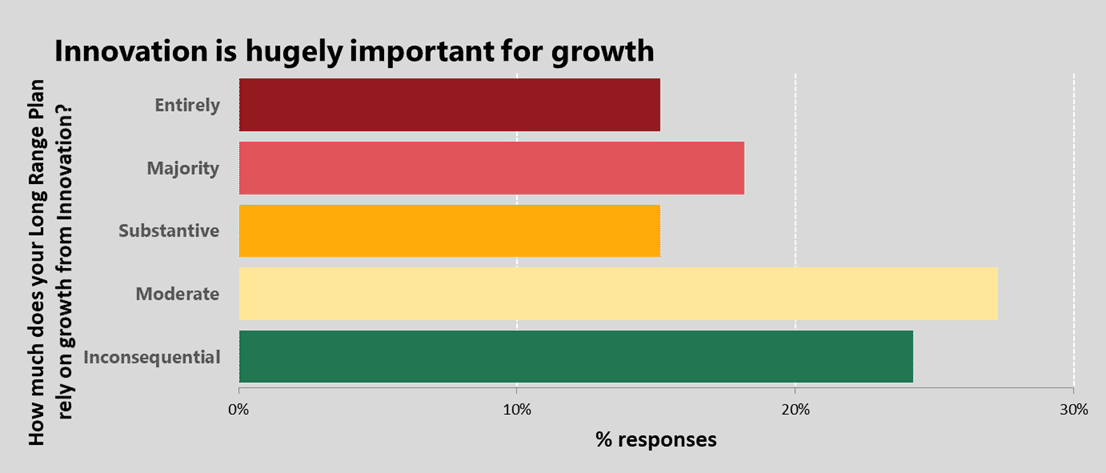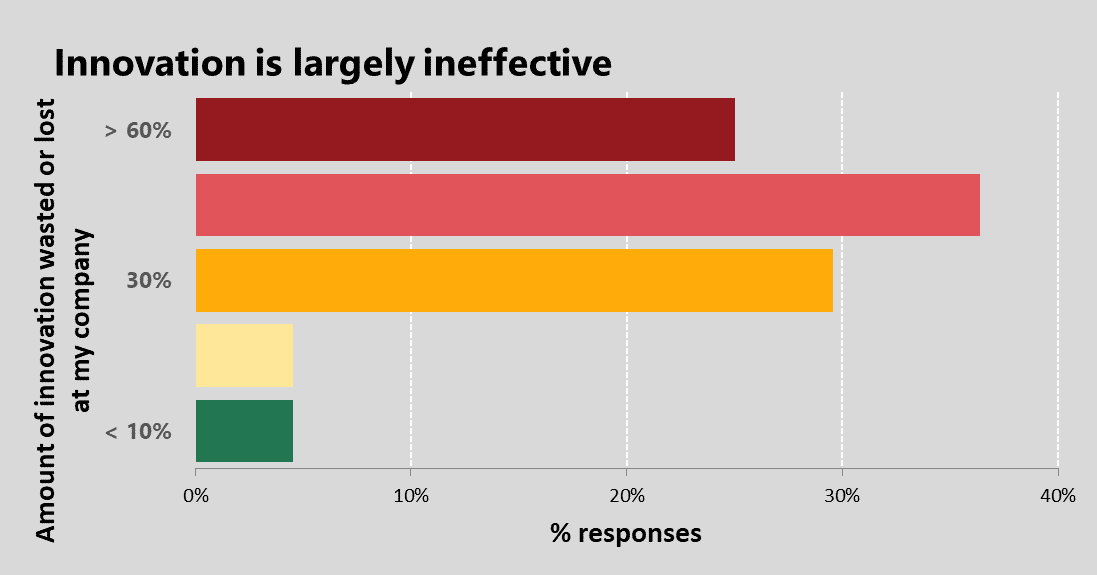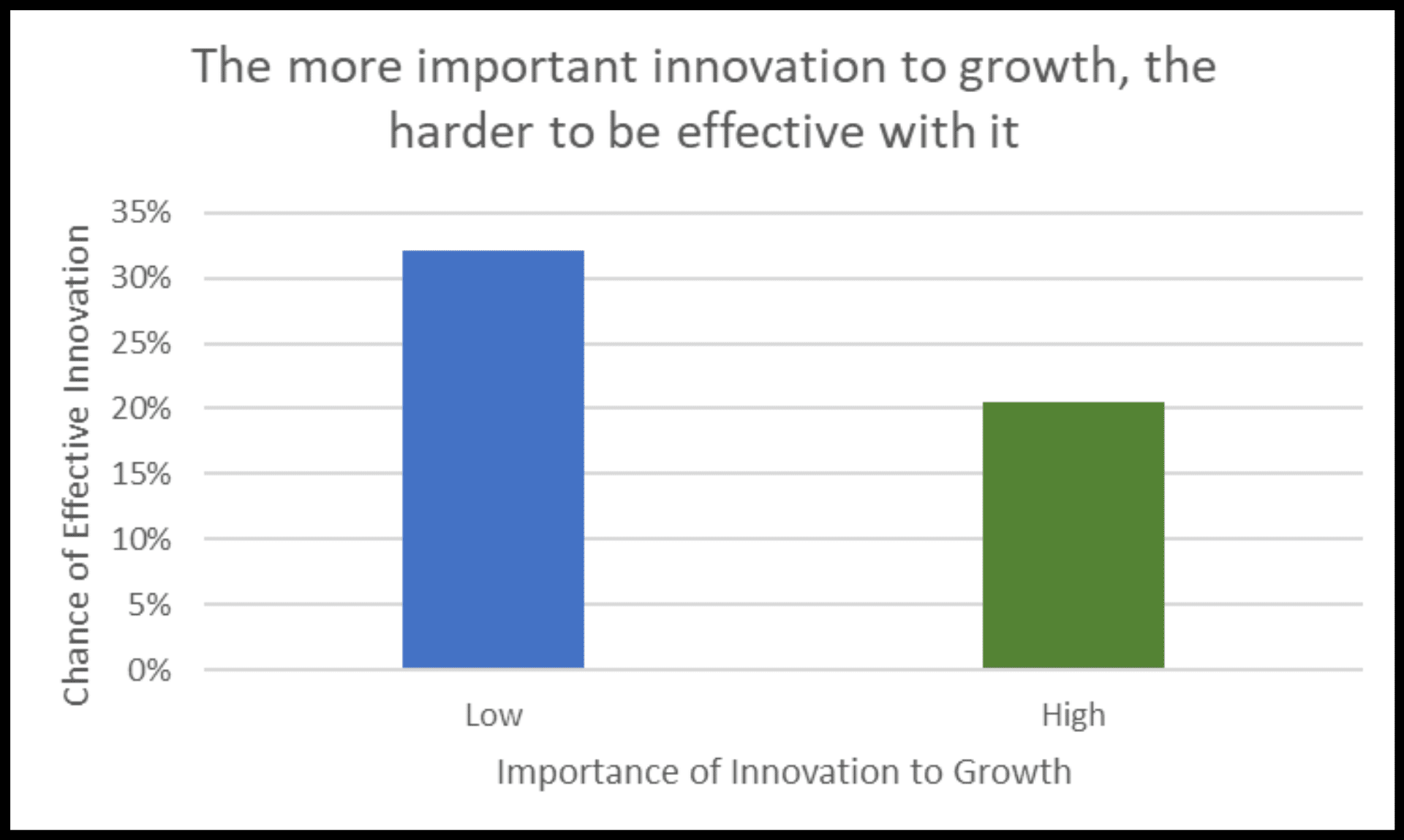The paradox of important but ineffective innovation: Lean Operators and Courageous Companies
By David Matheson  6 min read
6 min read
Innovation is important. The problem is it isn’t very effective.
At a recent event, my colleague, Ralph Morales III, polled the audience on the importance and effectiveness of innovation, and a paradox emerged: innovation is important but ineffective. On the importance side, 15% of the respondents reported their Long-Range Plan relied “Entirely” on innovation for growth (maroon category in the graph below) and 56% of the respondents said their Long-Range Plan relied at a “Substantive” or higher level on innovation for its growth (sum of the orange, pink, and maroon categories on the graph below).


On the effectiveness side, 25% reported that more than 60% of their innovation is wasted (maroon category in the graph below). A stunning 91% of the respondents reported that 30% or more of their innovation effort is wasted or lost (sum of the orange, pink, and maroon categories in the graph below) The litany of why innovation is ineffective is long, but Ralph’s talk offered solutions.
One might be tempted to conclude that we need to “get better” at, or “reduce waste” in, innovation. This conclusion is true enough, but it is a little simplistic as an exhortation. Further analysis of the data adds to the paradox: companies that put high importance on innovation to drive growth in their Long-Range Plans are LESS effective at innovation (see graph below). Said another way, it seems the more important innovation is to growth, the harder it is to be effective at it. Merely recognizing the importance of innovation, exhorting its improvement, or trying harder at it just doesn’t seem to work.

Reflecting on this paradox, I realized that companies experience waste in innovation for very different reasons; it depends on what they are trying to do with innovation. Some companies focus on continuous improvement in their operations, some want to refresh their product lines, some aim to move into adjacent markets or technologies, and some strive to build whole new lines of businesses. These different purposes of innovation lead to different expectations about the contribution of innovation to growth and to different levels of difficulty in making innovation effective.
To keep the analysis simple, we divided the myriad purposes of innovation into two broad strategies: the lean operator and the courageous company. The lean operator is focused on incremental innovation, emphasizing continuous improvement and product refreshes. While these innovations may deliver some growth, they typically hold the line, and companies approaching innovation in this way rely on other activities, such as capital improvements or M&A, to drive growth. These companies focus heavily on meeting their promises and reliably doing a little better each year. The relative importance of innovation to growth in the Long-Range Plan is low; our data shows 56% of respondents in this category.
The courageous companies are more focused on invention. They emphasize moving into adjacencies and creating entirely new lines of business. They commit to growth from innovation in their Long-Range Plans and commit to the courage required for that exploration. Our data shows 43% of companies in this category.

Slicing the poll data a different way, we analyzed the answers to both the importance and effectiveness questions together and the results were quite revealing. Only 9% of the respondents gave high importance to innovation and reported being effective in their innovation processes (green on graph below). These are courageous companies walking the talk of innovation and exhibiting a consistent strategy. Eighteen percent of the companies polled seem similarly consistent but on a lean operator strategy (blue on graph): while they don’t put much importance on innovation, they make sure the innovation they do fund is not wasted.
Unlike these companies, most companies trying one or the other of these strategies seem to blow it, but in different ways and with different solution paths to success.

Let’s start with the lean operator approach. Thirty-eight percent of companies say innovation isn’t important to growth and also say there are high levels of waste in innovation. This may at first seem consistent, but driving a lean strategy requires the elimination of waste. These companies are undisciplined in innovation. It’s fashionable to throw money at innovation these days, but that won’t cut it for the lean operator strategy.
Said another way, if your company intends to be a lean operator, you’ve only got a 32% chance of making innovation effective.
For a lean operator, effective innovation requires efficiency: exploiting clear opportunities and eliminating the speculative and unfamiliar. Lean operators need to focus on clear innovation wins: places that meet immediate and obvious needs and don’t represent much risk. Innovation will pay off, but it will likely represent incremental improvement and won’t drive much growth.
Companies that rely on innovation for growth fare even worse. Thirty-four percent of companies say innovation is important to growth but have ineffective innovation processes. These companies treat innovation like a lottery ticket, throwing money at it and hoping for a win. This approach is at best hopeful rather than courageous.
Said another way, if your company intends to be courageous, you’ve only got a 20% chance of making innovation effective. It’s harder to succeed at innovation as a courageous company than a lean operator company, but if done correctly, the upside can be significant.
For a courageous company to make innovation effective, it needs to rapidly discard things that don’t work and rapidly build up things that do. Courageous companies need to be willing to consider wilder or more speculative ideas, while at the same time making sure their efforts are focused on providing evidence of real value. It is essential that they quickly cancel explorations that don’t pan out and wholeheartedly pursue explorations that are demonstrating opportunity, even if they’re uncomfortable to the core business.
The effective approach for a courageous company is essentially an options strategy. Pay a little to learn something, then invest more if it is positive and abandon if it is negative. The key is to focus on things with the potential for dramatic impact, and to have the decision discipline to keep the portfolio of options dynamic.
Companies don’t necessarily fall into only one camp or the other, they are often a mix. Balancing innovation between these two strategies is a difficult trick and an important element of Strategic Portfolio Management. While most companies work to find a balance, I’ve found companies have an overriding assumption or implicit strategy to be lean operators or courageous companies. This underlying tone affects everything, including this precarious balance.
For example, I was presenting the results of a portfolio evaluation to the president of a multi-billion-dollar company. I reported that about half of her mid-term growth goals would come from reliable projects. The other half would only be achieved if one of the more speculative projects worked, and there was considerable upside if more than one of these worked out. There were plenty of these types of projects, the key was to manage them effectively as options. Her background and experience was as a lean operator, so she immediately asked me which ones and what she should hold them accountable to so as to deliver success. While she understood exploration and options thinking intellectually, her instinct was reliable delivery, and this instinct set a tone.
One significant source of waste occurs when innovation culture is misapplied from one strategy to the other. For example, when a Lean Operator type of company initiates courageous innovation, it can easily result in innovation theater and significant waste. On the other hand, a Courageous Company can fall into the trap of demonstrating and pursuing a small step, even though it won’t ever lead to a big growth opportunity.